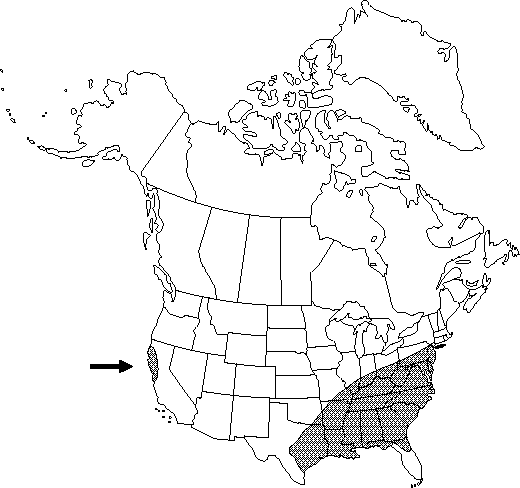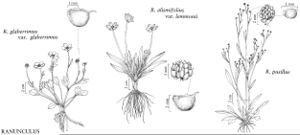Ranunculus pusillus
in J. Lamarck et al., Encycl. 6: 99. 1804.
Stems erect or ascending, rooting at most proximal nodes, glabrous. Roots not thickened basally, glabrous. Proximal cauline leaf blades ovate or lanceolate, 1.2-4.2 × 0.5-1.2 cm, base acute to truncate, margins entire or denticulate, apex acuminate to rounded. Inflorescences: bracts linear to lanceolate or oblanceolate. Flowers: receptacle glabrous; sepals 4-5, spreading or reflexed from base, 1.5-3 × 1-1.5 mm, glabrous or sparsely hirsute; petals 1-3, 1.5-2 × 0.5-1 mm; nectary scales glabrous. Heads of achenes hemispheric to cylindric, 2-8 × 2-3 mm; achenes 1-1.2 × 0.6-0.8 mm, ± tuberculate, glabrous; beak absent or nearly so, to 0.1 mm.
Phenology: Flowering spring (Apr–Jun).
Habitat: Ditches, ponds, and swamps
Elevation: 0-300 m
Distribution

Ala., Ark., Calif., Del., D.C., Fla., Ga., Ill., Ind., Ky., La., Md., Miss., Mo., N.J., N.Y., N.C., Ohio, Okla., Pa., S.C., Tenn., Tex., Va., W.Va.
Discussion
In most specimens of Ranunculus pusillus, the heads of achenes are hemispheric to short-ovate and only 2-3 mm. Occasional plants with cylindric heads of achenes 4-6 mm from the Gulf Coast states have been called R. pusillus var. angustifolius.
Selected References
None.
